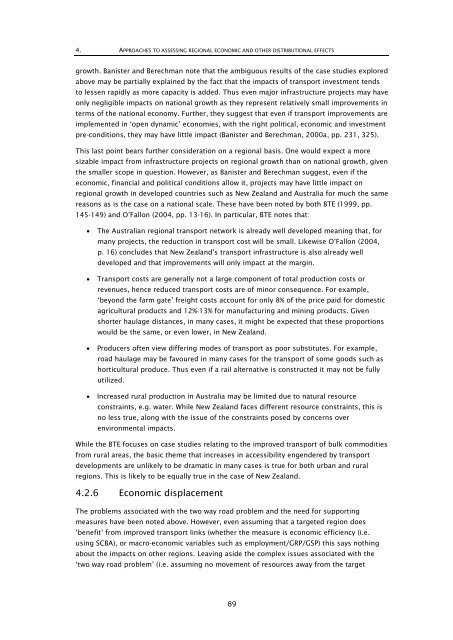Research 350 - NZ Transport Agency
Research 350 - NZ Transport Agency
Research 350 - NZ Transport Agency
You also want an ePaper? Increase the reach of your titles
YUMPU automatically turns print PDFs into web optimized ePapers that Google loves.
4. APPROACHES TO ASSESSING REGIONAL ECONOMIC AND OTHER DISTRIBUTIONAL EFFECTS<br />
growth. Banister and Berechman note that the ambiguous results of the case studies explored<br />
above may be partially explained by the fact that the impacts of transport investment tends<br />
to lessen rapidly as more capacity is added. Thus even major infrastructure projects may have<br />
only negligible impacts on national growth as they represent relatively small improvements in<br />
terms of the national economy. Further, they suggest that even if transport improvements are<br />
implemented in ‘open dynamic’ economies, with the right political, economic and investment<br />
pre-conditions, they may have little impact (Banister and Berechman, 2000a, pp. 231, 325).<br />
This last point bears further consideration on a regional basis. One would expect a more<br />
sizable impact from infrastructure projects on regional growth than on national growth, given<br />
the smaller scope in question. However, as Banister and Berechman suggest, even if the<br />
economic, financial and political conditions allow it, projects may have little impact on<br />
regional growth in developed countries such as New Zealand and Australia for much the same<br />
reasons as is the case on a national scale. These have been noted by both BTE (1999, pp.<br />
145-149) and O’Fallon (2004, pp. 13-16). In particular, BTE notes that:<br />
• The Australian regional transport network is already well developed meaning that, for<br />
many projects, the reduction in transport cost will be small. Likewise O’Fallon (2004,<br />
p. 16) concludes that New Zealand’s transport infrastructure is also already well<br />
developed and that improvements will only impact at the margin.<br />
• <strong>Transport</strong> costs are generally not a large component of total production costs or<br />
revenues, hence reduced transport costs are of minor consequence. For example,<br />
‘beyond the farm gate’ freight costs account for only 8% of the price paid for domestic<br />
agricultural products and 12%-13% for manufacturing and mining products. Given<br />
shorter haulage distances, in many cases, it might be expected that these proportions<br />
would be the same, or even lower, in New Zealand.<br />
• Producers often view differing modes of transport as poor substitutes. For example,<br />
road haulage may be favoured in many cases for the transport of some goods such as<br />
horticultural produce. Thus even if a rail alternative is constructed it may not be fully<br />
utilized.<br />
• Increased rural production in Australia may be limited due to natural resource<br />
constraints, e.g. water. While New Zealand faces different resource constraints, this is<br />
no less true, along with the issue of the constraints posed by concerns over<br />
environmental impacts.<br />
While the BTE focuses on case studies relating to the improved transport of bulk commodities<br />
from rural areas, the basic theme that increases in accessibility engendered by transport<br />
developments are unlikely to be dramatic in many cases is true for both urban and rural<br />
regions. This is likely to be equally true in the case of New Zealand.<br />
4.2.6 Economic displacement<br />
The problems associated with the two way road problem and the need for supporting<br />
measures have been noted above. However, even assuming that a targeted region does<br />
‘benefit’ from improved transport links (whether the measure is economic efficiency (i.e.<br />
using SCBA), or macro-economic variables such as employment/GRP/GSP) this says nothing<br />
about the impacts on other regions. Leaving aside the complex issues associated with the<br />
‘two way road problem’ (i.e. assuming no movement of resources away from the target<br />
89
















